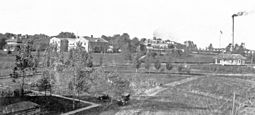- Oakdale, Iowa
-
Oakdale, Iowa — unincorporated community — Location of Oakdale within the state of Iowa Coordinates: 41°42′23″N 91°36′11″W / 41.70639°N 91.60306°WCoordinates: 41°42′23″N 91°36′11″W / 41.70639°N 91.60306°W[1] Country  United States
United StatesState  Iowa
IowaCounty Johnson County Elevation[1] 246 m (807 ft) Time zone Central (CST) (UTC-6) – Summer (DST) CDT (UTC-5) ZIP code 52319 Area code(s) 319 GNIS feature ID 459738 Oakdale was an unincorporated rural residential village established in 1908 [2] [3] by the State of Iowa as a state-wide treatment center for tuberculosis (TB) in rural Johnson County, located about five miles northwest of central Iowa City and now a part of Coralville, adjacent to the community of North Liberty.[4] The site was chosen for its remoteness, its location along a railroad,[5] and its proximity to University of Iowa Hospitals and Clinics in Iowa City.
As a partially self-sustaining community, Oakdale included a depot on the Cedar Rapids and Iowa City Railway (CRandIC) line,[6] power plant, several residential patient and staff buildings, pharmacy, postal, and administrative units, as well as associated facilities to support varied farming operations intended to help sustain the institution, including a large dairy. Treatment protocols during much of Oakdale's more than half-century of operation included a regimen of rest, fresh air year around,[7] and a nutritious diet. Before its naming in 1839, TB had been called "consumption" during much of its 4,500-year history as a human disease dating from Babylonian writings and Egyptian mummies.
Beginning with just eight patients but ending its first year with 45 in residence,[8] growth at Oakdale forced repeated expansions,[9] including a major one during 1926. Size of the associated farm ground also was increased to nearly 500 acres from an original 280 acres. Its patient census peaked during the 1940s at about 400. Improving public health standards, and following development of the first drug cure for TB in 1944, Oakdale usage declined and the facility was morphed briefly into an alcohol treatment center about 1960 as alternate uses were sought. The entire facility and land were transferred to University of Iowa ownership in 1965,[10] and the last tuberculosis patient was transferred to University Hospitals & Clinics in 1981.[11]
The university established its Agricultural Medical Research Facility at Oakdale in 1966 as the first of major evolution of this rural satellite campus, which now also serves the State Hygienic Laboratory in a new facility, as well as such other uses as the university's 197-acre Oakdale Research Park, where, among many other facilities, the National Advanced Driving Simulator[12] is located.
As a separate entity that also carries the Oakdale name because of its proximity, the Iowa prison system's Iowa Medical and Classification Center entry, medical and psychiatric units, as well as its maximum security facility, is located immediately across the road from the main Oakdale campus.
References
- ^ a b "Oakdale". Geographic Names Information System, U.S. Geological Survey. http://geonames.usgs.gov/pls/gnispublic/f?p=gnispq:3:::NO::P3_FID:459738. Retrieved 2011-06-04.
- ^ "Iowa Official Register" (1909-10) Office of the Secretary of State, State of Iowa, Des Moines, p268
- ^ Hibbs, Bob, "Iowa City" (2010) Arcadia Publishing "Postcard History Series", p15-16 including four photographs
- ^ "Iowa Official Register" (1906) Office of the Secretary of State, State of Iowa, Des Moines, p231-234
- ^ Mansheim, Gerald (1989) "Iowa City, an illustrated history" The Donning Co publishers p157 and photograph p158
- ^ Hibbs, Bob, "Saturday Postcard 194: Oakdale State Tuberculosis Sanatorium" (2003) Johnson County IAGenWeb Project, on line at http://iagenweb.org/johnson/PostcardHibbs/postcard12.htm
- ^ Hibbs, Bob "Iowa City" (2010) Arcadia Publishing "Postcard History Series p15 photo
- ^ "Iowa Official Register" (1909-10) Office of the Secretary of State, State of Iowa, Des Moines, p268
- ^ Hibbs, Bob, "Iowa City, a sense of place" (2006) Iowa City Press-Citizen publisher, p143
- ^ Mansheim, Gerald (1989) "Iowa City, an illustrated history" The Donning Co publishers p186
- ^ Scott, John Beldon and Lehnertz, Rodney P. (2006) "The University of Iowa Guide to Campus Architecture" The University of Iowa Press p204
- ^ Scott, John Beldon and Lehnertz, Rodney P. (2006) "The University of Iowa Guide to Campus Architecture" The University of Iowa Press p210
Municipalities and communities of Johnson County, Iowa Cities Coralville | Hills | Iowa City | Lone Tree | North Liberty | Oxford | Shueyville | Solon | Swisher | Tiffin | University Heights | West Branch‡
Townships Big Grove | Cedar | Clear Creek | East Lucas | Fremont | Graham | Hardin | Jefferson | Liberty | Lincoln | Madison | Monroe | Newport | Oxford | Penn | Pleasant Valley | Scott | Sharon | Union | Washington
Unincorporated
communitiesFootnotes ‡This populated place also has portions in an adjacent county or counties
Categories:- Populated places in Johnson County, Iowa
- Unincorporated communities in Iowa
Wikimedia Foundation. 2010.


